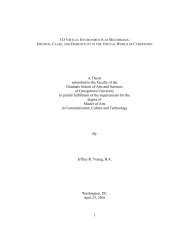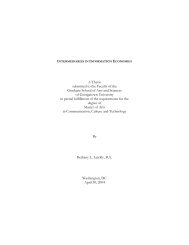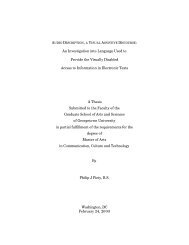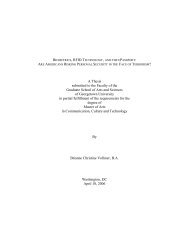A Comparative Case Study of Global Marketing and Ethnocentrism ...
A Comparative Case Study of Global Marketing and Ethnocentrism ...
A Comparative Case Study of Global Marketing and Ethnocentrism ...
You also want an ePaper? Increase the reach of your titles
YUMPU automatically turns print PDFs into web optimized ePapers that Google loves.
The E-scale was developed in 1950 <strong>and</strong> is hailed as the first scale ever to<br />
accurately represent a measure <strong>of</strong> ethnocentrism. It uses a questionnaire method <strong>and</strong> a<br />
Likert-type scale. It poses all questions in a negative format. That is, all items were<br />
hostile to the group in question (Adorno, et al 104-105). However, it is a bit outdated<br />
in its approach, as it was developed for the purpose <strong>of</strong> measuring classic attitudes <strong>of</strong><br />
racism <strong>and</strong> ethnicity. Some feel it is even inappropriate for the contemporary<br />
American situation (Shimp <strong>and</strong> Sharma 281).<br />
A more recent scale, based in part on the E-scale, is the CETSCALE<br />
constructed by Shimp <strong>and</strong> Sharma, both pr<strong>of</strong>essors <strong>of</strong> marketing in the College <strong>of</strong><br />
Business Administration at the University <strong>of</strong> South Carolina. The scale was developed<br />
as the first ever to accurately measure consumer ethnocentrism in America (280).<br />
Shimp <strong>and</strong> Sharma characterize this scale as a measure <strong>of</strong> ethnocentric “tendency”<br />
rather than “attitude” because the latter term suggests a greater degree <strong>of</strong> object<br />
specificity than the CETSCALE is intended to capture (Shimp <strong>and</strong> Sharma 281).<br />
Shimp <strong>and</strong> Sharma felt that it was necessary to construct a unique scale that<br />
would measure ethnocentrism differently than had ever been done before. The classic<br />
measure <strong>of</strong> ethnocentrism developed by Adorno is not directly relevant to consumer<br />
behavior, therefore Shimp <strong>and</strong> Sharma set out to create a better, more timely <strong>and</strong><br />
relevant model to study marketing phenomena specifically (Shimp <strong>and</strong> Sharma 281).<br />
The CETSCALE was tested against specific facts <strong>of</strong> consumers’ orientations toward<br />
foreign products: (1) consumer ethnocentric tendencies, (2) price-value perceptions,<br />
11






